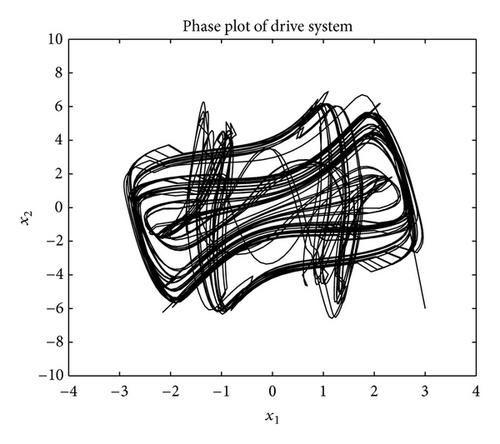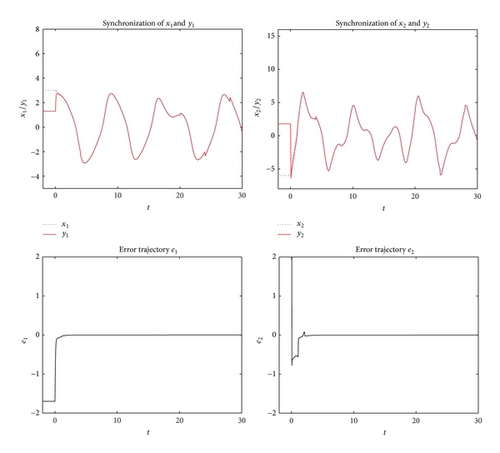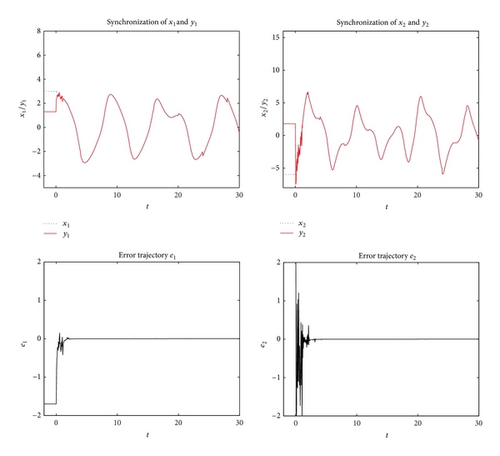Synchronization of Chaotic Delayed Fuzzy Neural Networks under Impulsive and Stochastic Perturbations
Abstract
The synchronization problem of chaotic fuzzy cellular neural networks with mixed delays is investigated. By an impulsive integrodifferential inequality and the Itô′s formula, some sufficient criteria to synchronize the networks under both impulsive and stochastic perturbations are obtained. The example and simulations are given to demonstrate the efficiency and advantages of the proposed results.
1. Introduction
Fuzzy cellular neural network (FCNN), which integrated fuzzy logic into the structure of a traditional cellular neural networks (CNNs) and maintained local connectivity among cells, was first introduced by T. Yang and L. Yang [1] to deal with some complexity, uncertainty, or vagueness in CNNs. Lots of studies have illustrated that FCNNs are a useful paradigm for image processing and pattern recognition [2]. So far, many important results on stability analysis and state estimation of FCNNs have been reported (see [3–12] and the references therein).
Recently, it has been revealed that if the network’s parameters and time delays are appropriately chosen, then neural networks can exhibit some complicated dynamics and even chaotic behaviors [13, 14]. The chaotic system exhibits unpredictable and irregular dynamics, and it has been found in many fields. Since the drive-response concept was proposed by Pecora and Carroll [15] in 1990 for constructing the synchronization of coupled chaotic systems, the control and synchronization problems of chaotic systems have been extensively investigated. In recent years, various synchronization schemes for chaotic neural networks have derived and demonstrated potential applications in many areas such as secure communication, image processing and harmonic oscillation generation; see [16–32].
Although there have been many results which can be applied to synchronization problems of a broad class of FCNNs [25–32], there are some disadvantages that need attention.
(1) Synchronization procedures and schemes are rather sensitive to the unavoidable channel disturbances which are usually presented in two forms: impulse and random noise. However, in [25–27], authors provided some new schemes to synchronize the chaotic systems without considering both impulse and random noise. In [28, 29], under the condition of no channel disturbance, Yu et al. and Xing and Peng studied the lag synchronization problems of FCNNs, respectively. In [30, 31], authors studied the synchronization of impulsive fuzzy cellular neural networks (IFCNNs) with delays. In [32], authors derived some synchronization schemes for FCNNs with random noise. In fact, in real system, it is more reasonable that the two perturbations coexist simultaneously.
(2) The criteria proposed in [25–32] are valid only for FCNNs with discrete delays. For example, in [25, 28, 30, 31], the involved delays are constants. In [26, 27, 32], the involved delays are time-varying delays which are continuously differentiable, and the corresponding derivatives are required to be finite or not greater than 1. In [29], Xing and Peng provided some new criteria on lag synchronization problem of FCNNs but they only considered the case for bounded time-varying delays. In fact, time delays may occur in an irregular fashion, and sometimes they may be not continuously differentiable. Besides this, distribution delays may also exist when neural networks have a spatial extent due to the presence of a multitude of parallel pathways with a variety of axon sizes and lengths.
(3) Some conditions imposed on the impulsive perturbations are too strong. For instance, Feng et al. [31] required the magnitude of jumps not to be smaller than 0 and not greater than 2. However, the disturbance in the real environment may be very intense.
Therefore, it is of great theoretical and practical significance to investigate synchronization problems of IFCNNs with mixed delays and random noise. However, up to now, to the best of our knowledge, no result for synchronization of IFNNs with mixed delays and random noise has been reported.
Inspired by the above discussion, this paper addresses the exponential synchronization problem of IFCNNs with mixed delays and random noise. Based on the properties of nonsingular ℳ-matrix and the It’s formula, we design some synchronization schemes with a state feedback controller to ensure the exponential synchronization control. Our method does not resort to complicated Lyapunov-Krasovskii functional which is widely used. The proposed synchronization schemes are novel and improve some of the previous literature.
This paper is organized as follows. In Section 2, we introduce the drive-response models and some preliminaries. In Section 3, some synchronization criteria for FCNNs with mixed delays are derived. In Section 4, an example and its simulations are given to illustrate the effectiveness of theoretical results. Finally, conclusions are drawn in Section 5.
2. Model Description and Preliminaries
Let ℝn be the space of n-dimensional real column vectors, and let ℝm×n represent the class of m × n matrices with real components. |·| denotes the Euclidean norm in ℝn. The inequality “≤” (“>”) between matrices or vectors such as A ≤ B (A > B) means that each pair of corresponding elements of A and B satisfies the inequality “≤” (“>”). A ∈ ℝm×n is called a nonnegative matrix if A ≥ 0, and x ∈ ℝn is called a positive vector if x > 0. The transpose of A ∈ ℝm×n or x ∈ ℝn is denoted by AT or xT. Let E denote the unit matrix with appropriate dimensions. 𝒩 : = {1,2, …, n}, and ℕ : = {1,2, …}, ℝ+ : = [0, +∞).
ℙℂ[J, ℝn] = {ψ : J → ℝn | ψ(s) is continuous and bounded for all but at most countable points s ∈ J and at these points, ψ(s+) and ψ(s−) exist, ψ(s) = ψ(s+)}. Here, J ⊂ ℝ is an interval; ψ(s+) and ψ(s−) denote the right-hand and left-hand limits of the function ψ(s), respectively. Especially ℙℂ : = ℙℂ[(−∞, 0], ℝn] with the norm ∥ψ∥ = sup −∞<s≤0 | ψ(s)| for ψ ∈ ℙℂ.
𝕃e = {ψ : ℝ+ → ℝ | ψ(s) is piecewise continuous and satisfies for some constant σ0 > 0}.
-
(A1) fi is globally Lipschitz continuous, that is, for any i ∈ 𝒩, there exists nonnegative constant Li such that
() -
(A2) For any k ∈ ℕ, there is a nonnegative constant ηk such that
()
-
(A3) for i ∈ 𝒩, there exist nonnegative constants cij, dij such that
()
For convenience, we use the following notations: D1 = diag {−c1, …, −cn}, L = diag {L1, …, Ln}, K(s) = (kij(s)) n×n, A = (aij) n×n, with , for i ≠ j, α = (αij) n×n, β = (βij) n×n, Γ = (γij) n×n, Θ = (θij) n×n, C = (cij) n×n, and D = (dij) n×n.
The following definition and lemmas will be employed.
Definition 1. The systems (2) and (5) are called to be globally exponentially synchronized in p-moment, if there exist positive constants λ, K such that
For any nonsingular ℳ-matrix A (see [34]), we define that
Lemma 2 (see [35].)For a nonsingular ℳ-matrix A, ℳA is a nonempty cone without conical surface.
Lemma 3 (see [36].)For xi ≥ 0, αi > 0, and ,
Lemma 4 (see [1].)Let αij, βij ∈ ℝ and x, y ∈ ℝn be the two states of the system (2). Then, one has
Lemma 5 (see [36].)For the integer p ≥ 2 and x = (x1, …, xn) T ∈ ℝn, there exists a positive constant ep(n) such that
Lemma 6. For k ∈ ℕ, assume that v = (v1(t), …, vn(t)) T ∈ ℙℂ[(−∞, +∞), ℝn] satisfies
-
(C1) A0 = diag {a1, …, an}, P = (pij) n×n with pij ≥ 0 for i ≠ j, Q = (qij) n×n ≥ 0, Υ(s) = (υij(s)) n×n ≥ 0, and υij ∈ 𝕃e, i, j ∈ 𝒩.
-
(C2) is a nonsingular ℳ-matrix.
Proof. By condition (C2) and Lemma 2, we can find such that , namely, . By the continuity, there must be some positive constant λ ∈ (0, σ0] satisfying
Let for t ∈ ℝ, i ∈ 𝒩. For any small enough ϵ > 0, (16) implies that vi(t) ≤ wi(t)<(1 + ϵ)wi(t), t ∈ (−∞, t0]. Next, we claim that for any t ∈ [t0, t1),
3. Exponential Synchronization
In this section, by using Lemma 6, we will obtain some sufficient criteria to synchronize the drive-response systems (2) and (5).
Theorem 7. Assume that (A1)–(A3) hold and
-
(A4) for p ≥ 2, is a nonsingular ℳ-matrix, where , , , D0 = diag {d1, …, dn} with
() -
(A5) the impulsive perturbations satisfy
()
Proof. Since is a nonsingular ℳ-matrix, by Lemma 2 and the continuity, there must be a constant vector and a constant λ ∈ (0, σ0] such that (31) holds.
We denote by e = (e1, …, en) T the solution of error dynamical system (8) with the initial value and let
By the continuity of EVi(e(t)), we conclude that
On the other hand, noting that e(t0 + s) = ψ(s) − ϕ(s) in (8) and by a simple calculation, we get
Therefore, by Lemma 6, we derive that
Remark 8. In [25–32], the authors established some useful criteria for ensuring synchronization of FCNNs with delays, respectively. However, once the unbounded distributed delays are involved, all results in [25–32] will be invalid. Hence, in this sense, the proposed Theorem 7 has a wider range of applications than those in previous papers.
Remark 9. In synchronization scheme, we take both impulsive perturbations and random noise into account. Comparing with the results in [25–32], Theorem 7 can reflect a more realistic dynamical behavior and synchronization procedure.
If the random noise has not been considered, which means σ ≡ 0 in (5), then the response system reduces to
Theorem 10. Assume that (A1) and (A2) hold and
-
(A6) is a nonsingular ℳ-matrix, where , ,
-
(A7) the impulsive perturbations satisfy
()
Proof. Let V(e(t)) = [e(t)] + = (|e1(t)|, …, |en(t) | ) T. Calculating the time derivative of V(e(t)) along with the trajectory of error system can give
Remark 11. In [31], Feng et al. derived some criteria on the globally exponential synchronization for a special case of (2) and (53) with γij = θij = 0, τij(t) = τij and for i, j ∈ 𝒩, k ∈ ℕ. In order to achieve synchronous control, the conditions as 0 ≤ ηik ≤ 2 for i ∈ 𝒩, k ∈ ℕ have been imposed on the impulsive perturbations. However, Theorem 10 drops these restrictions.
4. Illustrative Example
In this section, a numerical example and its simulations are given to illustrate the effectiveness of our results.
Example 1. Consider the following 2-dimensional IFCNNs with mixed delays as the drive system
Choosing the initial value ϕ(s) = (3, −6) T for s ∈ (−∞, 0], the drive system (57) possesses a chaotic behavior as shown in Figure 1.

Case 1. The response system without random noise is given by

Remark 12. It is worth noting that the impulsive perturbations Jk > 2, which are not a satisfied condition (H2) in [31]. That is to say, even in the absence of the unbounded distributed delays, the results in [31] still cannot be applied to the synchronization problem of (57) and (59).
Case 2. Consider the response system with random noise as follows:
For p = 2, let control gain matrices be
It is easy to deduce that

5. Conclusion
In this paper, we investigate the synchronization problem of IFCNNs with mixed delays. Based on the properties of nonsingularℳ-matrix and some stochastic analysis approaches, some useful synchronization criteria under both impulse and random noise are obtained. The methods used in this paper are novel and can be extended to many other types of neural networks. These problems will be considered in near future.
Acknowledgments
The authors thank the editor and reviewers for their useful comments. This work was supported by the National Natural Science Foundation of China under Grants 11271270 and 61273021 and the Natural Science Foundation Project of CQ CSTC 2011jjA00012.




